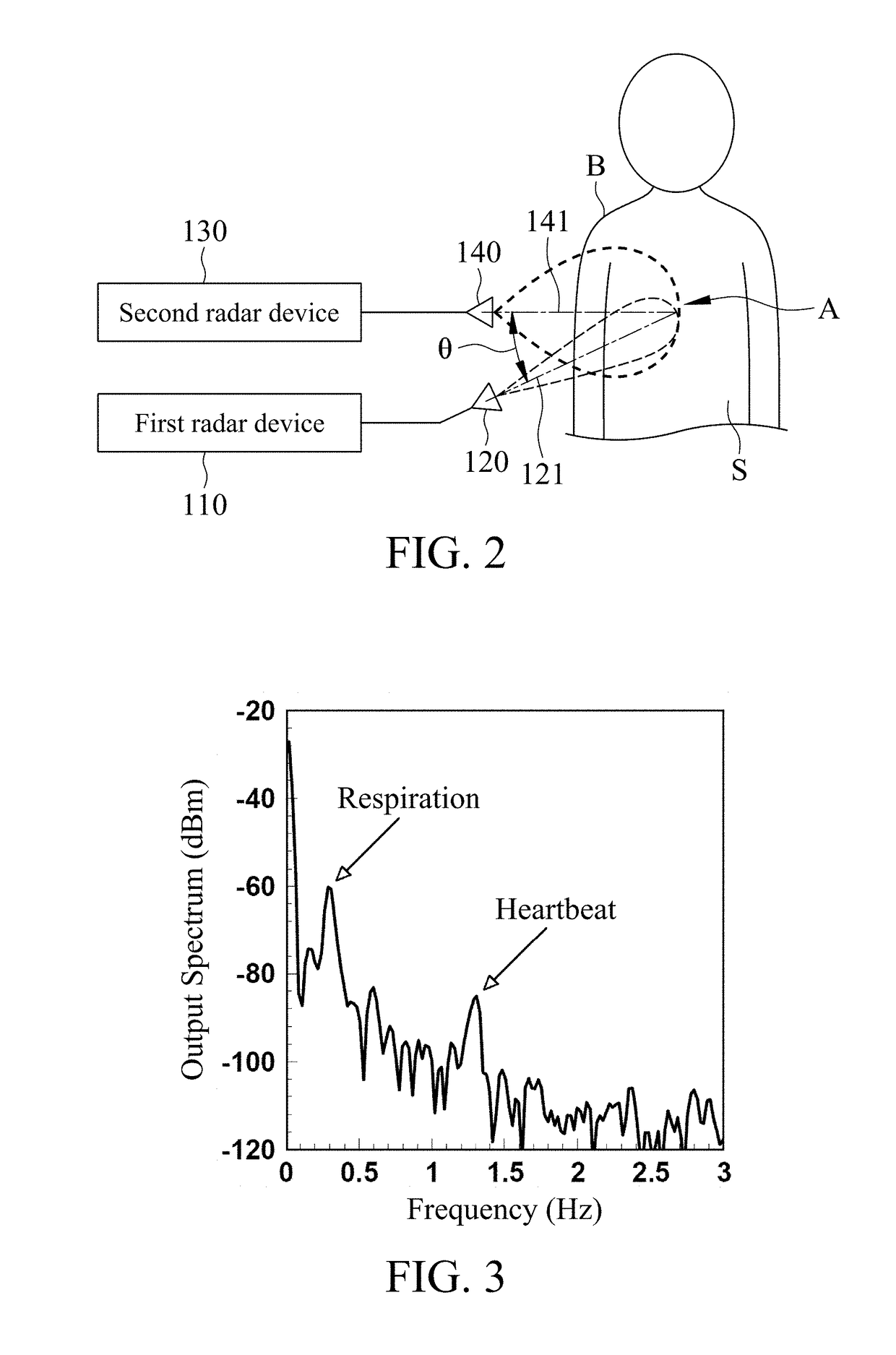Non-contact vital sign monitoring system
a vital sign and non-contact technology, applied in the field of non-contact vital sign monitoring system, can solve the problems of system configuration limitations, subject to feel uncomfortable during monitoring, and doppler shift affecting the vital sign monitoring
- Summary
- Abstract
- Description
- Claims
- Application Information
AI Technical Summary
Benefits of technology
Problems solved by technology
Method used
Image
Examples
first embodiment
[0017]With reference to FIG. 1, a non-contact vital sign monitoring system 100 in accordance with the present invention comprises a first radar device 110, a first antenna 120, a second radar device 130 and a second antenna 140.
[0018]With reference to FIG. 1, the first radar device 110 includes a first frequency demodulation and control unit 111, a first voltage-controlled oscillator (VCO) 112 and an amplitude and phase adjusting unit 113, wherein the first VCO 112 is electrically connected with the first frequency demodulation and control unit 111 and the amplitude and phase adjusting unit 113. The first frequency demodulation and control unit 111 is used for controlling the frequency of a first transmission signal E1 generated from the first VCO 112 and demodulating an output signal O1 from the first VCO 112, wherein the first transmission signal E1 is delivered to the amplitude and phase adjusting unit 113, and the amplitude and phase adjusting unit 113 is used for adjusting the ...
second embodiment
[0027]With reference to FIG. 2, the first antenna 120 and the second antenna 140 in the present invention are setup in an up-down configuration, wherein the first antenna 120 has a first central axis 121 and the second antenna 140 has a second central axis 141, and the first central axis 121 and the second central axis 141 both are directed to an area A on the side S of the biological subject B. The second central axis 141 is parallel to floor substantially, and the first central axis 121 is tilted relative to floor to form an included angle θ of less than 90 degrees between the first central axis 121 and the second central axis 141. In this embodiment, the included angle θ is 55 degrees when the system operates in the 2.4 GHz industrial, scientific and medical band.
[0028]Owing to the gain of the first antenna 120 is higher than that of the second antenna 140 in this embodiment, the magnitude of the first reflected signal R1 received by the first antenna 120 will be higher than that...
third embodiment
[0030]With reference to FIG. 5, the first antenna 120 and the second antenna 140 in the present invention are setup in a front-rear configuration, wherein the first antenna 120 has a first central axis 121 and the second antenna 140 has a second central axis 141, and the first central axis 121 and the second central axis 141 both are directed to an area A on the side S of the biological subject B. There is a distance D between the first antenna 120 and the second antenna 140, and the second antenna 140 is located between the first antenna 120 and the biological subject B. In this embodiment, the distance D is 20 cm when the system operates in the 2.4 GHz industrial, scientific and medical band.
[0031]In the setup of the first antenna 120 and the second antenna 140 of the third embodiment, the first transmission signal E1 transmitted from the first antenna 120 is partially blocked by the metal plate of the second antenna 140 to decrease the Doppler component of the first reflected sig...
PUM
 Login to View More
Login to View More Abstract
Description
Claims
Application Information
 Login to View More
Login to View More - R&D
- Intellectual Property
- Life Sciences
- Materials
- Tech Scout
- Unparalleled Data Quality
- Higher Quality Content
- 60% Fewer Hallucinations
Browse by: Latest US Patents, China's latest patents, Technical Efficacy Thesaurus, Application Domain, Technology Topic, Popular Technical Reports.
© 2025 PatSnap. All rights reserved.Legal|Privacy policy|Modern Slavery Act Transparency Statement|Sitemap|About US| Contact US: help@patsnap.com



